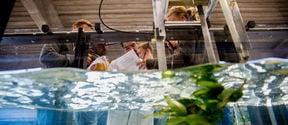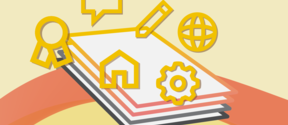Goals for the curriculum design work in 2024–2026
Our shared goals in curriculum design are integrating sustainability themes into programmes, strengthening our lifewide learning offering, and implementing the new language guidelines.


Curriculum development consists of four identifiable stages that are implemented over the curriculum period’s two-year span. The development may be seen as a continuing work in progress, for development of the next new curriculum may begin immediately after the publication of the current one. The stages may be adapted according to the needs of the degree programme or major.
Stages of curriculum development:
Curriculum development starts with a comprehensive knowledge-based self-evaluation of the programme and its curriculum.
The curriculum’s success in different areas is assessed in the self-evaluation. The self-evaluation is based on feedback and statistical data which, together with input from the teaching community, stakeholders and students, create a foundation for understanding the current state of the programme.
Aalto University takes part in national and international evaluations, audits and benchmarking activities, and regularly self-evaluates its own planning and implementation processes in the areas of teaching and learning. In addition, Aalto monitors its students’ academic progress, graduation and employment, and collects feedback from students during the time of their studies as well as feedback from employers and graduates on the quality of Aalto's education and the competencies Aalto graduates have acquired.
The assessment of the programme and its curriculum takes place in the following stages:
Data about teaching and studying is one of the key bases that support the monitoring, evaluation and development of education and our programmes.

Aalto University takes part in national and international evaluations, audits and benchmarking activities, and self-evaluates its own planning and implementation processes in the areas of teaching and learning. In addition, Aalto monitors its students’ academic progress, graduation and employment, and collects feedback on the quality of education and learning from employers and graduates. Internal and external evaluations are conducted in accordance with a multiyear evaluation programme.

In Aalto, feedback is collected from students during different phases of their studies. Hearing the voice of students is vital for the development of teaching and training as well as for quality assurance and for improving study-related services. Feedback is used on multiple levels in many ways and its utilisation is a special area of focus in Aalto. Student guilds and organisations are also interested in and benefit from feedback and surveys.

Curriculum development goals are identified and set based on a curriculum assessment that has been carried out.
The goals are defined on the basis of analysing assessment data with teaching staff, students and stakeholders. Setting the development goals focuses on synchronisation and prioritisation of internal and external aims, drawing up a concrete short-term and long-term action plan, and monitoring the plan’s implementation.
The setting of development goals is based on an assessment that is conducted in the following stages:

Our shared goals in curriculum design are integrating sustainability themes into programmes, strengthening our lifewide learning offering, and implementing the new language guidelines.
Educational alignment refers to a state of cohesion and consistency between the intended learning outcomes and content of teaching, the assessment methods, and the study climate. Alignment may be viewed as alignment between different courses, or between a planned course and its specific implementation. Alignment may also be viewed at the level of the curriculum as a whole.
Alignment between the level of the degree and the whole programme is also significant for course alignment: in a well-planned, cohesive degree programme, students develop competencies in a logical progression, deepening their previous learning while avoiding excessive repetition. An example of this is when new skills are adapted and put into practice only after the student has been introduced and made familiar with the subject through previous studies.
Essential to achieving alignment is to have a shared understanding about building the curriculum and its joint planning at the programme level. Collaborative planning of the curriculum ensures that students have a variety of ways and methods to learn during their degree studies and make step-by-step progress in developing their competencies. Cohesion, alignment and predictability in study paths promote student well-being and motivation. At its best, a curriculum that is planned collaboratively may increase the well-being of the workplace community as well.
Curriculum alignment is developed through the following stages:
Aalto’s way of working is based on the PDCA cycle (Plan–Do–Check–Act). After the curriculum is published and teaching has begun, the process of continual development proceeds by promoting a teaching culture that encourages feedback and interactivity.
Feedback is an instrument whereby teachers can strengthen their own interaction with students and assess and improve their own work and work outcomes.
While teaching and learning is occurring, teaching can be developed through the following stages:

Aalto University takes part in national and international evaluations, audits and benchmarking activities, and self-evaluates its own planning and implementation processes in the areas of teaching and learning. In addition, Aalto monitors its students’ academic progress, graduation and employment, and collects feedback on the quality of education and learning from employers and graduates. Internal and external evaluations are conducted in accordance with a multiyear evaluation programme.

In Aalto, feedback is collected from students during different phases of their studies. Hearing the voice of students is vital for the development of teaching and training as well as for quality assurance and for improving study-related services. Feedback is used on multiple levels in many ways and its utilisation is a special area of focus in Aalto. Student guilds and organisations are also interested in and benefit from feedback and surveys.

Course feedback is a unique part of the feedback portfolio in Aalto University and it reaches students in all phases of their studies and is collected systematically throughout Aalto. Hearing the voice of students is vital for the development of teaching and education as well as for quality assurance and for improving study-related services. The course feedback tool can be found in MyCourses. Feedback is used on multiple levels in many ways and its utilisation is a special focus area at Aalto.

This handbook contains practical information for a teacher on teaching at Aalto University.

The quality management of Aalto University is based on the principle of continuous development, the PDCA cycle (Plan-do-Check-ACT).

Central to community and inclusion is that the community members feel accepted and valued as themselves. Belonging to a study community means gaining experiences of the relevance of studies and identification with the student community. The sense of belonging is unique and can only be triggered if students identify themselves with the community. That is why it is important to think how to create and promote the sense of inclusion in your teaching.

Aalto University’s curriculum design guidelines and schedule aims at supporting sustainable, future led degree programmes.